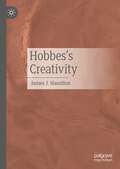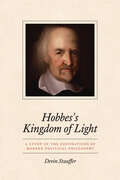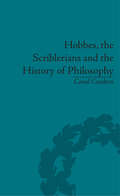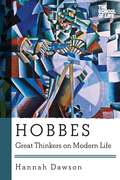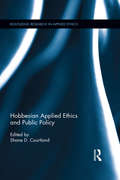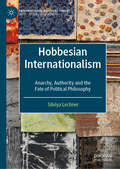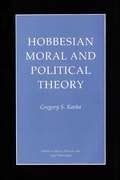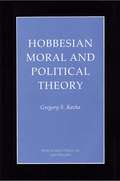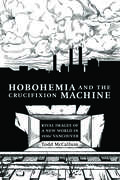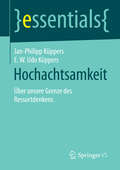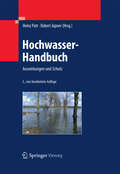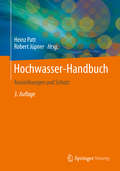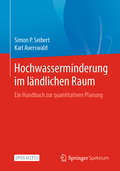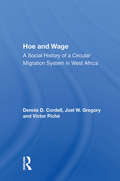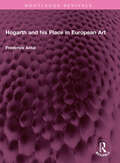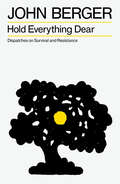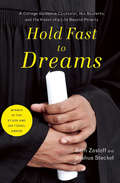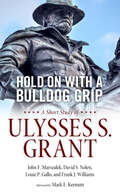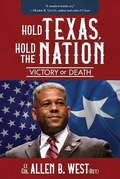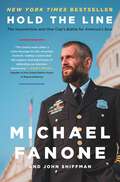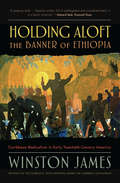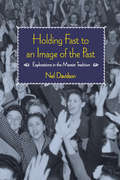- Table View
- List View
Hobbes's Creativity
by James J. HamiltonThis book approaches Hobbes's philosophy from a completely new perspective: his creativity. Creativity is the production of something which experts consider to be original, valuable and of high quality. James Hamilton explores Hobbes's creativity by focusing on his development, personality, and motivation in the context of his culture and environment, and on the ways in which he thought creatively, as inferred from his writings. Identification of the ideas which Hobbes drew upon is an important part of the study for two reasons. First, they are necessary to determine which of Hobbes's ideas and theories are original and which are not. Second, analysis of his creativity requires an understanding of the ideas from which he drew. Hamilton concludes that Hobbes became a great philosopher because of his creative virtuosity.
Hobbes's Kingdom of Light: A Study of the Foundations of Modern Political Philosophy
by Devin StaufferWas Hobbes the first great architect of modern political philosophy? Highly critical of the classical tradition in philosophy, particularly Aristotle, Hobbes thought that he had established a new science of morality and politics. Devin Stauffer here delves into Hobbes’s critique of the classical tradition, making this oft-neglected aspect of the philosopher’s thought the basis of a new, comprehensive interpretation of his political philosophy. In Hobbes’s Kingdom of Light, Stauffer argues that Hobbes was engaged in a struggle on multiple fronts against forces, both philosophic and religious, that he thought had long distorted philosophy and destroyed the prospects of a lasting peace in politics. By exploring the twists and turns of Hobbes’s arguments, not only in his famous Leviathan but throughout his corpus, Stauffer uncovers the details of Hobbes’s critique of an older outlook, rooted in classical philosophy and Christian theology, and reveals the complexity of Hobbes’s war against the “Kingdom of Darkness.” He also describes the key features of the new outlook—the “Kingdom of Light”—that Hobbes sought to put in its place. Hobbes’s venture helped to prepare the way for the later emergence of modern liberalism and modern secularism. Hobbes’s Kingdom of Light is a wide-ranging and ambitious exploration of Hobbes’s thought.
Hobbes, the Scriblerians and the History of Philosophy
by Conal CondrenSatire was core to the work of Thomas Hobbes although his critics also used it as a weapon to ridicule him. Condren uses Hobbes as an example to demonstrate that an examination of the persona is needed to advance our understanding of a writer's philosophy.
Hobbes: A Very Short Introduction
by Richard TuckThomas Hobbes (1588-1679) was the first great English political philosopher, and his book Leviathan was one of the first truly modern works of philosophy. Richard Tuck shows that while Hobbes may indeed have been an atheist, he was far from pessimistic about human nature, nor did he advocate totalitarianism. By locating him against the context of his age, we learn that Hobbes developed a theory of knowledge which rivaled that of Descartes in its importance for the formation of modern philosophy.
Hobbes: Great Thinkers on Modern Life
by Hannah DawsonHe elevated politics to a science and in his quest to find a way for society to achieve peace, Thomas Hobbes provided a secular justification for the state, and laid the foundations for modern sociology in the process. His mighty Leviathan and other works can still provide guidance on navigating society and politics today. Thomas Hobbes was an English philosopher who was roiled by the bloodshed and turmoil of the English Civil War. During this period of ceaseless in-fighting, he wrote his masterpiece, Leviathan, which established the foundation for Western political thought. His work has inspired both hate and awe, as he reveals the darker side of human nature and the value of authority. Though he claims man's nature is inherently competitive and selfish, he also shows us how to utilize these traits to our advantage to flourish, be fearless, and free.
Hobbes: Morals and Politics (Political Thinkers Ser.)
by D D Raphael D. D. RaphaelFirst published in 1977 this book is both expository and critical and concentres on Hobbes' ethical and political theory, but also considering the effect on these of his metaphysics. Updated, with a new preface especially for this re-issue, which brings together recent scholarship on Hobbes, a particular useful feature of the book is the new, critical bibliography.
Hobbesian Applied Ethics and Public Policy (Routledge Research in Applied Ethics)
by Shane D. CourtlandMost philosophers and political scientists readily admit that Thomas Hobbes is a significant figure in the history of political thought. His theory was, arguably, one of the first to provide a justification for political legitimacy from the perspective of each individual subject. Many excellent books and articles have examined the justification and structure of Hobbes’ commonwealth, ethical system, and interpretation of Christianity. What is troubling is that the Hobbesian project has been largely missing in the applied ethics and public policy literature. We often find applications of Kantian deontology, Bentham’s or Mill’s utilitarianism, Rawls’s contractualism, the ethics of care, and various iterations of virtue ethics. Hobbesian accounts are routinely ignored and often derided. This is unfortunate because Hobbes’s project offers a unique perspective. To ignore it, when such a perspective would be fruitful to apply to another set of theoretical questions, is a problem in need of a remedy. This volume seeks to eliminate (or, at the very least, partially fill) this gap in the literature. Not only will this volume appeal to those that are generally familiar with Hobbesian scholarship, it will also appeal to a variety of readers that are largely unfamiliar with Hobbes.
Hobbesian Internationalism: Anarchy, Authority and the Fate of Political Philosophy (International Political Theory)
by Silviya LechnerThis book sets out to re-examine the foundations of Thomas Hobbes’s political philosophy, and to develop a Hobbesian normative theory of international relations. Its central thesis is that two concepts – anarchy and authority – constitute the core of Hobbes's political philosophy whose aim is to justify the state. The Hobbesian state is a type of authority (juridical, public, coercive, and supreme) which emerges under conditions of anarchy ('state of nature'). A state-of-nature argument makes a difference because it justifies authority without appeal to moral obligation. The book shows that the closest analogue of a Hobbesian authority in international relations is Kant's confederation of free states, where states enjoy 'anarchical' (equal) freedom. At present, this crucial form of freedom is being threatened by economic processes of globalisation, and by the resurgence of private authority across state borders.
Hobbesian Moral And Political Theory
by Gregory S. KavkaIn recent years serious attempts have been made to systematize and develop the moral and political themes of great philosophers of the past. Kant, Locke, Marx, and the classical utilitarians all have their current defenders and arc taken seriously as expositors of sound moral and political views. It is the aim of this book to introduce Hobbes into this select group by presenting a plausible moral and political theory inspired by Leviathan. Using the techniques of analytic philosophy and elementary game theory, the author develops a Hobbesian argument that justifies the liberal State and reconciles the rights and interests of rational individuals with their obligations. Hobbes's case against anarchy, based on his notorious claim that life outside the political State would be a "war of all against all," is analyzed in detail, while his endorsement of the absolutist State is traced to certain false hypotheses about political sociology. With these eliminated, Hobbes's principles support a liberal redistributive (or "satisfactory") State and a limited right of revolution. Turning to normative issues, the book explains Hobbes's account of morality based on enlightened self-interest and shows how the Hobbesian version of social contract theory justifies the political obligations of citizens of satisfactory States.
Hobbesian Moral and Political Theory (Studies in Moral, Political, and Legal Philosophy #6)
by Gregory S. KavkaIn recent years serious attempts have been made to systematize and develop the moral and political themes of great philosophers of the past. Kant, Locke, Marx, and the classical utilitarians all have their current defenders and arc taken seriously as expositors of sound moral and political views. It is the aim of this book to introduce Hobbes into this select group by presenting a plausible moral and political theory inspired by Leviathan. Using the techniques of analytic philosophy and elementary game theory, the author develops a Hobbesian argument that justifies the liberal State and reconciles the rights and interests of rational individuals with their obligations.Hobbes's case against anarchy, based on his notorious claim that life outside the political State would be a "war of all against all," is analyzed in detail, while his endorsement of the absolutist State is traced to certain false hypotheses about political sociology. With these eliminated, Hobbes's principles support a liberal redistributive (or "satisfactory") State and a limited right of revolution. Turning to normative issues, the book explains Hobbes's account of morality based on enlightened self-interest and shows how the Hobbesian version of social contract theory justifies the political obligations of citizens of satisfactory States.
Hobohemia and the Crucifixion Machine: Rival Images of a New World in 1930s Vancouver
by Todd MccallumIn the early years of the Great Depression, thousands of unemployed homeless transients settled into Vancouver’s “hobo jungle.” The jungle operated as a distinct community, in which goods were exchanged and shared directly, without benefit of currency. The organization of life was immediate and consensual, conducted in the absence of capital accumulation. But as the transients moved from the jungles to the city, they made innumerable demands on Vancouver’s Relief Department, consuming financial resources at a rate that threatened the city with bankruptcy. In response, the municipality instituted a card-control system—no longer offering relief recipients currency to do with as they chose. It also implemented new investigative and assessment procedures, including office spies, to weed out organizational inefficiencies. McCallum argues that, threatened by this “ungovernable society,” Vancouver’s Relief Department employed Fordist management methods that ultimately stripped the transients of their individuality. Vancouver’s municipal government entered into contractual relationships with dozens of private businesses, tendering bids for meals in much the same fashion as for printing jobs and construction projects. As a result, entrepreneurs clamoured to get their share of the state spending. With the emergence of work relief camps, the provincial government harnessed the only currency that homeless men possessed: their muscle. This new form of unfree labour aided the province in developing its tourist driven “image” economy, as well as facilitating the transportation of natural resources and manufactured goods. It also led eventually to the most significant protest movement of 1930s’ Canada, the On-to-Ottawa Trek. Hobohemia and the Crucifixion Machine explores the connections between the history of transiency and that of Fordism, offering a new interpretation of the economic and political crises that wracked Canada in the early years of the Great Depression.
Hochachtsamkeit: Über unsere Grenze des Ressortdenkens (essentials)
by Jan-Philipp Küppers E. W. Udo KüppersDieses Essential vermittelt einen grundlegenden Einblick in die Hochachtsamkeit als Ressortgrenzen überwindende Art zu denken und zu handeln. An wachsenden Krisenherden und Umbruchsituationen in Gesellschaft und Politik sind Organisationen, ihre Strukturen und Abläufe nicht gänzlich unbeteiligt. Die Autoren erläutern auf leicht verständliche Weise, welchen Wert Hochachtsamkeit für Problemlösungen bietet und welche Rolle dabei ein besseres Verständnis von Organisationsstrukturen und darin stattfindenden Arbeitsprozessen einnimmt.
Hochwasser-Handbuch
by Heinz Patt Robert JüpnerHochwasser verursacht jedes Jahr Sachschäden in Milliardenhöhe. Das Handbuch bietet die notwendigen Informationen, wenn es darum geht, die richtigen Maßnahmen zur Verbesserung des Hochwasserschutzes zu finden. Lösungsansätze und Berechnungsbeispiele liefert ein Autorenteam aus hochkarätigen Wissenschaftlern und Praktikern. In der Neuauflage finden die strategischen und technischen Entwicklungen der letzten 10 Jahre Berücksichtigung, die Darstellung der gesetzlichen Grundlagen wurde aktualisiert (u. a. EU-Hochwasserschutzrichtlinie).
Hochwasser-Handbuch: Auswirkungen und Schutz
by Heinz Patt Robert JüpnerHochwasser verursacht jedes Jahr Sachschäden in Milliardenhöhe. Das Handbuch bietet die notwendigen Informationen, wenn es darum geht, die richtigen Maßnahmen zur Verbesserung des Hochwasserschutzes zu finden. Lösungsansätze und Berechnungsbeispiele liefert ein Autorenteam aus hochkarätigen Wissenschaftlern und Praktikern. In der Neuauflage finden die strategischen und technischen Entwicklungen der letzten 10 Jahre Berücksichtigung, die Darstellung der gesetzlichen Grundlagen wurde aktualisiert (u. a. EU-Hochwasserschutzrichtlinie).
Hochwasserminderung im ländlichen Raum: Ein Handbuch zur quantitativen Planung
by Simon P. Seibert Karl AuerswaldDiese Open-Access-Publikation ist ein anwendungsorientiertes Lehr- und Handbuch zur Abflussminderung im ländlichen Raum. Meteorologische Extreme wie Dürren, Starkregen und Überschwemmungen häufen sich wegen des Klimawandels. Gleichzeitig steigt der Druck auf unsere Landschaft kontinuierlich, indem sie immer intensiver genutzt und effizienter erschlossen wird. Durch diese Entwicklungen ergeben sich dringende Herausforderungen für den ländlichen Hochwasserschutz und den Erhalt unserer natürlichen Ressourcen Wasser und Boden.Das Buch beschreibt Methoden für die Planung von Maßnahmen zur Abflussminderung. Es ist speziell für kleine Einzugsgebiete ( Die Autoren:Dr. Simon P. Seibert ist Ingenieurökologe und hat über die Entstehung und Modellierung von Hochwasser in München und Karlsruhe promoviert. Seit Mitte 2019 leitet er der Arbeitsgruppe Gebietshydrologie am Bayerischen Landesamt für Umwelt.Prof. Dr. Karl Auerswald lehrt am Wissenschaftszentrum Weihenstephan für Ernährung, Landnutzung und Umwelt der TU München. Seine Forschungsschwerpunkte der vergangenen 40 Jahre sind agrarökologische Prozesse, insbesondere der Wasserhaushalt von Landschaften, Böden, Pflanzen und Tieren.
Hoe And Wage: A Social History Of A Circular Migration System In West Africa
by Dennis D. CordellBased on an unusual source a retrospective survey of migration from 1900 to 1975 this book traces the history of internal and international labor migration in colonial and contemporary Burkina Faso, the West African coast, and other parts of Africa. Interviews with returned migrants elicited information about age, matrimonial status, motives for migrating, employment, destinations, residence, and motives for returning. The survey, which includes data on nearly one hundred thousand migrants and on 1.5 million instances of migration, offers a uniquely African perspective on migration in the region .
Hogarth and his Place in European Art (Routledge Revivals)
by Frederick AntalFirst published in 1962, Hogarth and his Place in European Art attempts to convey the historical relevance, both in its native and European context, of perhaps the most outstanding English painter of the eighteenth century. Dr. Antal applies his method of establishing the close relationship between the political and social history and the arts and letters of the period. Thus, the book goes far beyond the limits of art historical appreciation. It gives a panoramic picture of the first half of the eighteenth century in England with all its social, literary, and artistic connotations. He shows how England, which during those years became both politically and economically the most advanced country in Europe, could provide in Hogarth, in spite of the slender native tradition, the most progressive artistic personality of his time – whose work revealed the views and tastes of a broad cross-section of society. He traces Hogarth’s stylistic origins back to their European sources and analyses his impact on contemporary European and English art as well as the influence he exerted on generations to come. This book will be of interest to students of art, art history, literature, and European history.
Hold Everything Dear: Dispatches on Survival and Resistance
by John BergerA powerful meditation on political resistance and the global search for justiceFrom the &‘War on Terror&’ to resistance in Ramallah and traumatic dislocation in the Middle East, Berger explores the uses of art as an instrument of political resistance. Visceral and passionate, Hold Everything Dear is a profound meditation on the far extremes of human behaviour, and the underlying despair. Looking at Afghanistan, Palestine and Iraq, he makes an impassioned attack on the poverty and loss of freedom at the heart of such unnecessary suffering.These essays offer reflections on the political at the core of artistic expression and at the center of human existence itself.
Hold Fast to Dreams: A College Guidance Counselor, His Students, and the Vision of a Life Beyond Poverty
by Beth Zasloff Joshua SteckelAn &“invaluable&” memoir by a counselor who left the elite private-school world to help poor and working-class kids get into college (Washington Monthly). Winner of the Studs and Ida Terkel Award Joshua Steckel left an elite Manhattan school to serve as the first-ever college guidance counselor at a Brooklyn public high school—and has helped hundreds of disadvantaged kids gain acceptance. But getting in is only one part of the drama. This riveting work of narrative nonfiction follows the lives of ten of Josh&’s students as they navigate the vast, obstacle-ridden landscape of college in America, where students for whom the stakes of education are highest find unequal access and inadequate support. Among the students we meet are Mike, who writes his essays from a homeless shelter and is torn between his longing to get away to an idyllic campus and his fear of leaving his family in desperate circumstances; Santiago, a talented, motivated, and undocumented student, who battles bureaucracy and low expectations as he seeks a life outside the low-wage world of manual labor; and Ashley, who pursues her ambition to become a doctor with almost superhuman drive—but then forges a path that challenges received wisdom about the value of an elite liberal arts education. At a time when the idea of &“college for all&” is hotly debated, this book uncovers, in heartrending detail, the ways the American education system fails in its promise as a ladder to opportunity—yet provides hope in its portrayal of the intelligence, resilience, and everyday heroics of young people whose potential is too often ignored. &“A profound examination of the obstacles faced by low-income students . . . and the kinds of reforms needed to make higher education and the upward mobility it promises more accessible.&” —Booklist
Hold On with a Bulldog Grip: A Short Study of Ulysses S. Grant
by John F. Marszalek Frank Williams David Nolen Louie GalloIn this new short biography of Ulysses S. Grant, leading scholars provide an accessible introduction to Grant and his legacy. Grant led Federal forces to victory in the Civil War, was the first modern American president, and authored his memoirs, which would eventually become one of the greatest books of nonfiction by an American author. The authors present a thematic exploration of Grant, providing the necessary insight to appreciate Grant and correct the myths that for too long clouded his true importance. They highlight specific moments or relationships in Grant’s life—including his connection to such key figures as Abraham Lincoln and Mark Twain—and elaborate on the more controversial elements of Grant’s legacy, such as accusations about his drinking and corruption during the Grant presidency. Not to overlook his military accomplishments, they devote time to the study of Grant’s war strategy and military career, beginning as early as his reluctant enrollment into West Point. From humble birth to tragic death, this new take on Ulysses S. Grant instills readers with a deeper understanding of the military legend’s nuanced personal history and an appreciation for the late president’s tragic and triumphant story.
Hold Texas, Hold the Nation: Victory or Death
by Lt. Col. Allen WestA former Congressman and the author of We Can Overcome presents his case for a conservative Texas.Texas is booming. In recent years, the Lone Star State has experienced some of the most rapid growth in the country, both in its economy and in its population. This is thanks to an influx of businesses relocating to Texas to take advantage of all its benefits. But this increase in population has also brought about a shift in the political dialogue within Texas’s borders.As more people pour into Texas, they bring with them liberal and socialist ideologies as they try to swing the state from red to blue. These plans for changing policies will suffocate the highly successful capitalist state and its residents, and according to Lt. Col. Allen West (Ret.), allowing these liberal ideals to creep into the legislative branch will be the death of Texas. In Hold Texas, Hold the Nation: Victory or Death, West explains how the longstanding conservative capitalist policies within the state’s government have allowed it to flourish over the years, providing hard-to-ignore evidence and allowing his experience in Congress to support his argument. He makes his stand, asserting that Texas must hold fast to its conservative ways and resist succumbing to liberal mindsets, or else cease to prosper, and begin to perish.Texas is a sustaining force for America, truly embodying the founding principles of the nation: those unalienable individual rights of life, liberty, and the pursuit of happiness. In Texas, it’s “Victory or Death.”Praise for Hold Texas, Hold the Nation“A must-read for anyone who bleeds red, white, and blue.” —Brian Kilmeade, cohost, Fox & Friends; host, The Brian Kilmeade Show; New York Times bestselling author
Hold Your Nose and Vote: Why Do Some Democracies Tolerate Corruption?
by Marco PaniA report from the International Monetary Fund.
Hold the Line: The Insurrection and One Cop's Battle for America's Soul
by John Shiffman Michael FanoneAn urgent warning about the growing threat to our democracy from a twenty-year police veteran and former Trump supporter who nearly lost his life during the insurrection of January 6th. <p><p>When Michael Fanone self-deployed to the Capitol on January 6, 2021, he had no idea his life was about to change. When he got to the front of the line, he urged his fellow officers to hold it against the growing crowd of insurrectionists—until he found himself pulled into the mob, tased until he had a heart attack, and viciously beaten with a Blue Lives Matter flag as shouts to kill him rang out. <p><p>Now, Fanone is ready to tell the full story of that fateful day, along with exploring our country’s most critical issues as someone who has had firsthand experience with many of them. A self-described redneck who voted for Trump in 2016, Fanone’s closest friend was an informant—a Black, transgender, HIV-positive woman who has helped him mature and rethink his methods as a police officer. <p><p>With his unique insight as an undercover detective and intense desire to do the right thing no matter the cost, Fanone provides a nuanced look into everything from policing to race to politics in a way that is accessible across all party lines. Determined to make sure no one forgets what happened at the Capitol on January 6th, Fanone has written a timely call to action for anyone who wants to preserve our democracy for future generations. <p> <b>New York Times Bestseller</b>
Holding Aloft the Banner of Ethiopia: Caribbean Radicalism in Early-Twentieth Century America
by Winston JamesA major history of the impact of Caribbean migration to the United States. Marcus Garvey, Claude McKay, Claudia Jones, C.L.R. James, Stokely Carmichael, Louis Farakhan—the roster of immigrants from the Caribbean who have made a profound impact on the development of radical politics in the United States is extensive. In this magisterial and lavishly illustrated work, Winston James focuses on the twentieth century&’s first waves of immigrants from the Caribbean and their contribution to political dissidence in America. Examining the way in which the characteristics of the societies they left shaped their perceptions of the land to which they traveled, Winston James draws sharp differences between Hispanic and English-speaking arrivals. He explores the interconnections between the Cuban independence struggle, Puerto Rican nationalism, Afro-American feminism, and black communism in the first turbulent decades of the twentieth century. He also provides fascinating insights into the impact of Puerto Rican radicalism in New York City and recounts the remarkable story of Afro-Cuban radicalism in Florida.
Holding Fast to an Image of the Past
by Neil DavidsonDavidson explores classic themes in historical materialism as he explains: the moments of transition from the dominance of one mode of production to another; the process of social revolution which accompany these transitions; and the problem of nationalism, both as a theoretical challenge to Marxism's capacity for historical explanation and as a practical obstacle to socialist consciousness.
